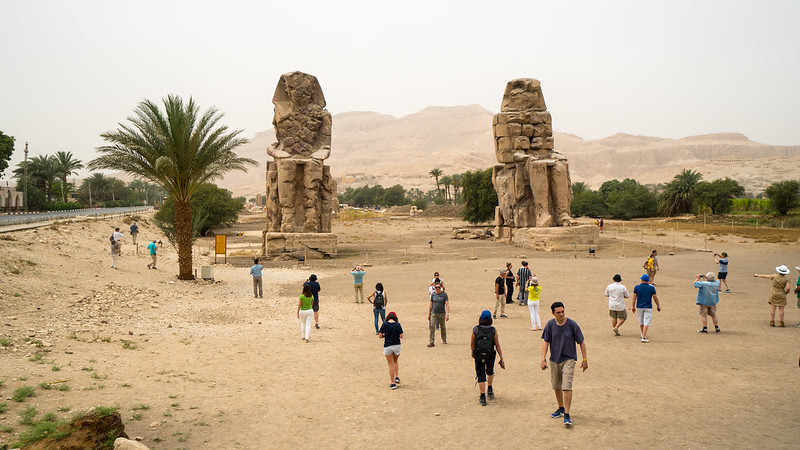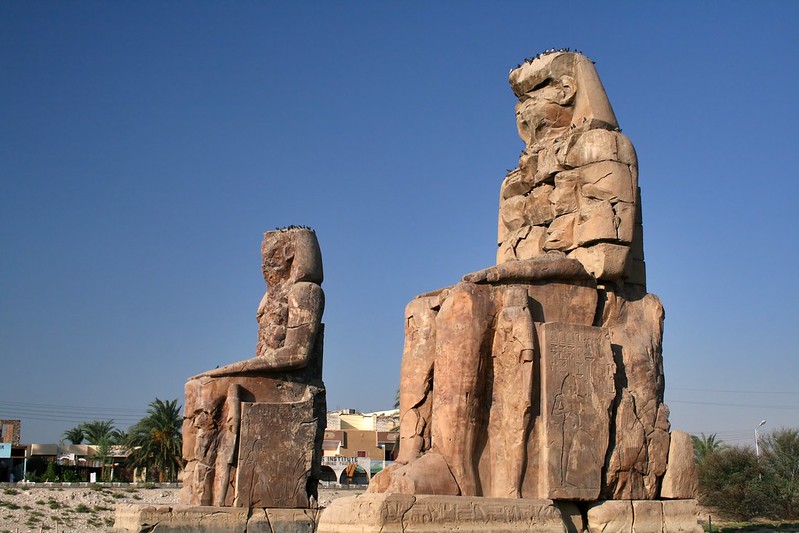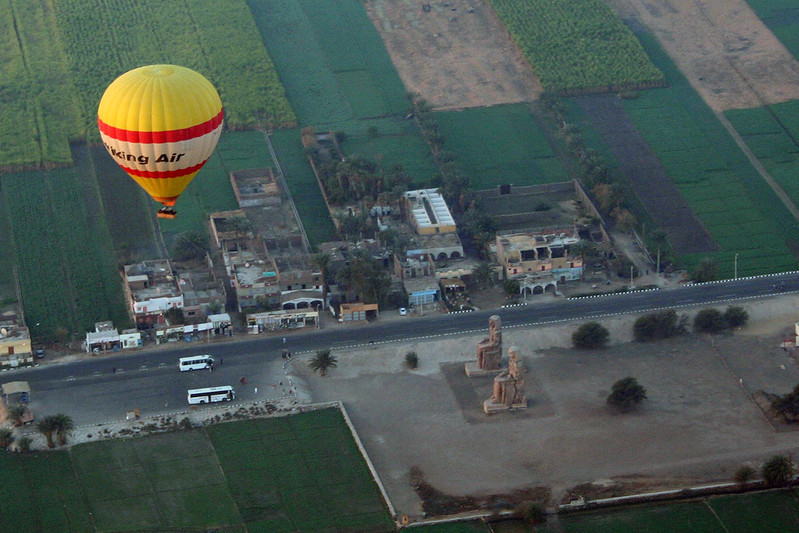Two monumental statues, the Colossi of Memnon or el-Salamat (also known by el-Colossat and el-Salamat), represent Amenhotep III (1386-1353 BCE), of Egypt's 18th Dynasty. They are situated west of Luxor, Egypt and face the Nile River. The statues depict the seated King on a throne with symbols of his mother, wife, and the god Happy. Each figure is 720 tonnes and stands 18 meters tall. They were carved from single blocks made of sandstone.
Coloss
Colossi of Memnon Statue – They were built to protect Amenhotep III’s mortuary complex, which used to be behind them. The huge complex was destroyed by floods, earthquakes, and ancient practice of using older monuments as material for new constructions. It is now largely gone, except for two monumental statues that once stood at its gates.
Colossal seated statue of a Pharaoh – Their names derive from Memnon, the Greek hero who died at Troy. Memnon, an Ethiopian king, was killed by Achilles the Greek champion. He was fighting on the Trojans' side against the Greeks. Memnon was praised for his bravery and combat skills, which earned him the title of a hero among the Greeks.
Colossi of Amenhotep III – Greek tourists who saw the magnificent statues linked them to the legend of Memnon rather than Amenhotep III and this link was further suggested by Manetho (3rd century BCE Egyptian historian) who claimed Memnon's father and Amenhotep III were one person.
Singing Statues Egypt – After one of the statues started making sounds that could be interpreted as oracles, the Greek writers called the whole complex the Memnonium. The Colossi has been a popular tourist attraction since ancient times. Today, graffiti that was left on the base by thousands of people from thousands of years back can be seen.
The Colossi of Memnon
Memnon Egypt – Numerous chasms opened in the ground after the 1200 BCE earthquake. Hourig Sourouzian (Armenian/German archaeologist) has done extensive restoration and excavations to reveal that the complex was composed of three pylons each with colossal statues.
Colossi of Memmon – The rectangular Temple complex at the far end was made up of a peristyle Court surrounded with columns. Four of the statues have been restored, and eight more are still in need of restoration. There are 200 statues or fragments of statues in the Luxor Museum.
Colossi of Thebes
Colossus of Memnon Egypt – Although the modern Arabic name for the Temple of Memnon is Kom el-Hatan is the name it goes by, the Temple of Memnon is more commonly known as the Temple of Memnon in Rome. Memnon, a hero in the Trojan War and a King of Ethiopia, led his armies across Africa to Asia Minor to defend the city. However, Achilles killed him. Memnon, which means the Steadfast and Resolute, was thought to be the son Eos the goddess of dawn. Because of the cry of the northern statue at dawn (see below), Memnon was often associated with colossi that were built centuries before him. This became the Colossus of Memnon. The entire Theban Necropolis was eventually referred to as "the Memnonium", which is a reference to him as "Ruler of West" in the same way Osiris, who was the chief of the west.
William de Wiveleslie Abney, a 19th-century historian, noted that the Arabs called these statues "Shama" and "Tama", and gave them the name of Sanamat when they spoke of them together.
Colossi of Memnon Egypt
Colossi of Memnon
Al Bairat, Al Qarna, Luxor
Colossi of Memnon are two massive stone statues of Pharaoh Amenhotep III










No comments:
Post a Comment